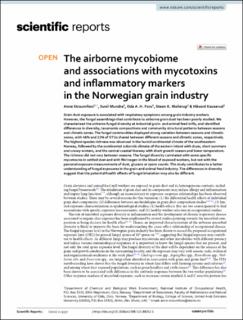| dc.description.abstract | Grain dust exposure is associated with respiratory symptoms among grain industry workers. However, the fungal assemblage that contribute to airborne grain dust has been poorly studied. We characterized the airborne fungal diversity at industrial grain- and animal feed mills, and identified differences in diversity, taxonomic compositions and community structural patterns between seasons and climatic zones. The fungal communities displayed strong variation between seasons and climatic zones, with 46% and 21% of OTUs shared between different seasons and climatic zones, respectively. The highest species richness was observed in the humid continental climate of the southeastern Norway, followed by the continental subarctic climate of the eastern inland with dryer, short summers and snowy winters, and the central coastal Norway with short growth season and lower temperature. The richness did not vary between seasons. The fungal diversity correlated with some specific mycotoxins in settled dust and with fibrinogen in the blood of exposed workers, but not with the personal exposure measurements of dust, glucans or spore counts. The study contributes to a better understanding of fungal exposures in the grain and animal feed industry. The differences in diversity suggest that the potential health effects of fungal inhalation may also be different. | |
